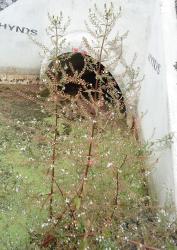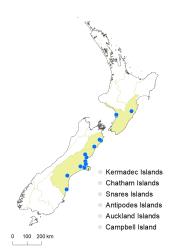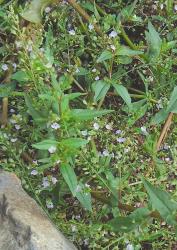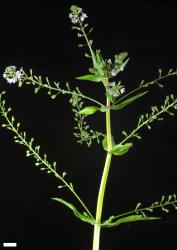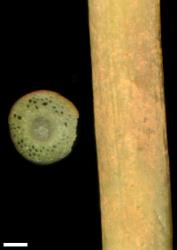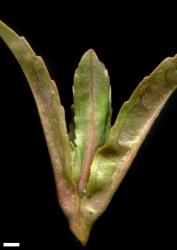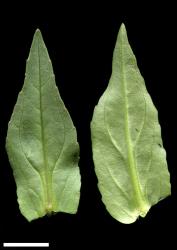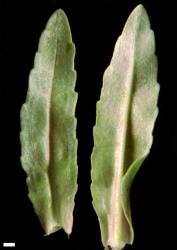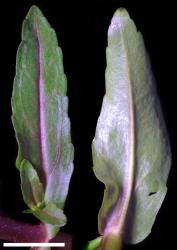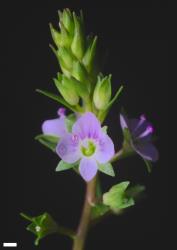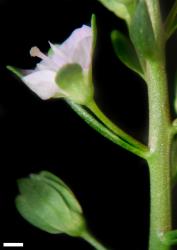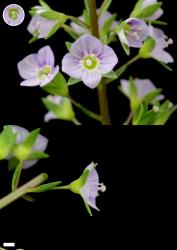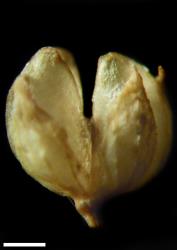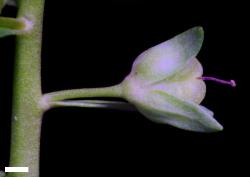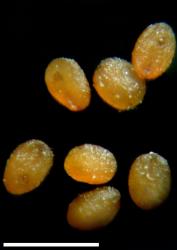- = Veronica aquatica Bernh., Begr. Pflanzenart 66 (1834) nom. illeg., non Veronica aquatica S.F.Gray 1821
Perennial herb to 0.7 m tall. Stems ascending to erect from prostrate base, glabrous. Leaf bud indistinct; leaves separating while small, opposite-decussate, spreading; lamina thin, linear to lanceolate or narrowly triangular, 15–100 mm long, 3–35 mm wide, somewhat glossy green to dark green above, dull pale green to green beneath; midrib and lateral veins evident; surfaces glabrous; margin glabrous, serrulate to serrate; teeth in 10–40 pairs; apex acute to acuminate; base sub-cordate to cordate, amplexicaul; petiole absent. Inflorescence a lateral raceme, sometimes branched below, 70–150 (rarely to 250) mm long; flowers crowded at first, becoming distant at fruiting, 10–50, all bisexual; bracts alternate, linear, > pedicels at flowering; pedicels erecto-patent to spreading, 1.5–2.0 mm long at flowering, 3–5 mm long at fruiting, sparsely to moderately glandular hairy all around. Calyx lobes 4, obtuse to acute, 3–4 mm long, sub-equal, glabrous. Corolla 3.5–5.0 mm diameter; tube white and greenish-yellow, c. 0.5 mm long, < calyx, glabrous or sparsely eglandular-hairy inside; lobes 4, pale pink, erecto-patent to spreading, sub-equal, elliptic to orbicular, 1.8–2.0 mm long, rounded to obtuse; nectar guides magenta, usually absent on anterior lobe. Stamen filaments white or pink, 1.5–2.0 mm long; anthers pink. Style glabrous, 1.5–2.0 mm long. Capsules angustiseptate, shallowly emarginate, glabrous or sparsely glandular-ciliate on margins, 2.0–3.0 mm long, 2.5–3.5 mm at widest point. Seeds ellipsoid or oblong, flattened on face, rounded on back, smooth, pale brown to brown, 0.5–0.6 mm long.
Veronica catenata plants are very similar to V. anagallis-aquatica and very easily confused with it, especially as some plants of V. anagallis-aquatica have pinkish flowers. V. anagallis-aquatica is distinguished by duller and paler leaves, glabrous inflorescences, a larger corolla, which is 5–10 mm diameter and has ovate to rhomboid lobes and coloured veins on all lobes, and its bracts are shorter than the pedicels, even at flowering. The corolla tube in V. anagallis-aquatica is densely hairy within.
V. americana plants are similar and also grow in wet places; they are distinguished by short petioles even on the uppermost leaves, completely glabrous inflorescences and capsules, longer pedicels, larger (7–10 mm) and blue flowers, longer styles 3.0–4.5 mm, and larger capsules 3.0–4.0 × 3.0–4.3 mm.
Plants of a fourth aquatic species, V. scutellata, are very slender and weak-stemmed, with very narrow leaves and filiform inflorescences that are only one at each node; their deeply emarginate or didymous capsules are larger and distinctly flattened, and their seeds are 1.2–1.4 mm long with a central chalaza.
North Island: Southern North Island (Waipukurau, Lake Koputara, Pukepuke Lagoon).
South Island: Marlborough (Kekerengu, Clarence Reserve, Chalk Range), Canterbury (Waipara, Hurunui, Woodend, Tai Tapu, Motukarara, Ōpihi, Oamaru).
Drains, swamps, stream sides, wet places. Most known sites are close to the coast. Recorded elevations range from 0 to 91 m.
Healy (1944, p. 228, as Veronica anagallis Linn.). Voucher CHR 41293, Healy, Waitohi R.
The hybrid V. anagallis-aquatica × catenata is common in Europe but has not been recorded in New Zealand. It closely resembles V. catenata but doesn’t produce fruit.
Flowers: September–April; fruits: September–April.
2n = 36 based on overseas material (Albach et al. 2008).
Veronica catenata is classified in V. subg. Beccabunga (Albach et al. 2004; Albach & Meudt 2010) along with similar aquatic species V. anagallis-aquatica and V. americana, and also V. peregrina and V. serpyllifolia.



